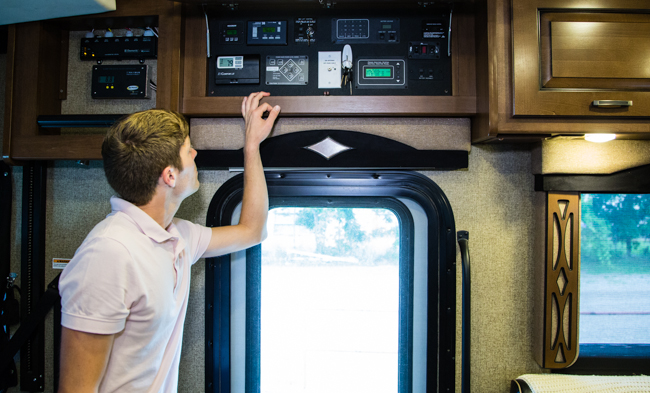How RV Heating and Cooling Really Work

Using the climate control in an RV is simple, but there are a few things that make it different than using a home system.
Understanding when to run the propane furnace vs. the heat pump, how to most efficiently run both A/C units and locating the remote temperature sensors will make the RV life a little more comfortable.
In our first year of RV travel we must have blown through hundreds of dollars worth of propane because we didn’t understand how the heating systems worked. On the flip side during summer trips we ran the A/C almost non-stop because we couldn’t get the RV to cool down and stay cool. Now we’re on our third class A RV and we like to think we’ve got it down fairly well, so I’m sharing a few of the tips and tricks we’ve learned over the years about Heating and Cooling an RV.
Our Excursion is equipped with two 13,500 btu low-profile Air Conditioning Units; the bedroom A/C has a built in heat pump and living room A/C does not. We also have two propane Furnaces for heating the RV; the furnace in the bedroom is 25,000 btu and the furnace in the living area is 20,000 btu. All of this is controlled with the industry standard digital RV Comfort thermostat controller (at least for most class A RVs). When I asked why we only have one A/C with a heat pump I was told the A/C units without the heat pump are a lot less expensive. So there ya go!
Thermostats and Temperature Sensors

As with most newer RV’s the thermostat is pre-set for our specific RV climate controls. “Zone 1” controls the living area and “Zone 2” controls the bedroom (some RV’s have 2 separate thermostats entirely). Our RV has two remote temperature sensors (it’s that little black plastic circle with a horizontal line through it on the wall) which is totally different than a home system where the temperature sensor is built directly into the thermostat. The first remote sensor is located just behind the driver’s seat attached to the sidewall of a cabinet and the second is located in the bedroom near the foot of our bed. Knowing where these little thermostats are located is important for conserving propane in the winter and electricity in the summer. For example the thermostat in our bedroom is located just above the furnace register so in winter we have to compensate by setting the temperature higher if we want the back to stay warm. Our sensor in the living area is located just inches from an exterior wall, the slide out and a giant window combined with the fact it’s at eye height; so in summer the temperature here reads 5+ degrees warmer at the sensor than in the kitchen area.
Keeping the RV Cool
To rapidly cool the living area on hot days try closing all the vents in the bedroom, opening the vents on the front A/C along with all the vents in the living area, shut the door to the back area of the RV and crank up both A/C units. Having the rear vents closed will force most of the cold air into the larger part of the coach and help it cool down quickly. If necessary close all the shades, especially if the sun is coming in the driver’s area. Of course you may need to do the “power shuffle” if you’re connected to 30a shore power!
When driving an RV in the Summer the heat can be a beast! The built in HVAC for the cab is nowhere near strong enough to cool the entire RV, so when you’re driving in extreme heat it may be necessary to run the generator to power the living area A/C to cool down the RV. I’ve even had RVers tell me that running the generator to power the roof A/C is more fuel efficient than running the cab A/C, although I haven’t done any extensive testing of this theory myself. We have driven through the desert a few times in the summer and I know it sounds ridiculous but sometimes you really need to run both A/C units to survive the heat coming in through the giant windshield, this was especially an issue with our first 2 Front Engine Diesel RVs. While driving the Excursion in warmer months we try and keep the bedroom door closed, and all the rear A/C vents closed, because the rear engine diesel leaks a lot of heat into the back of the RV. If we were in a gas coach that heat would be up front by our feet, so this is where a rear engine diesel comes in handy. However in the winter it’s the opposite. (see our post on diesel vs gas here)

A few things I have learned (the hard way):
1. Our first class A RV was 31 feet and only had one 15,000 btu A/C unit. I remember sitting at the lake in Dallas, with the temperatures soaring into the triple digits…that A/C ran non-stop and the temperature inside the RV never cooled below 94 degrees. One A/C unit is not enough to cool a 28’ or larger RV in high temps, you need two A/C’s!
2. If you want to capture the condensation water from the A/C unit it is possible to distill the water or at least kill the bacteria with a Camelbak All-Clear type of device. I am mentioning this because I keep getting asked and I’m not sure why, my opinion is if you’re running the A/C enough to produce that much water then you’re not really worried about conserving energy so why bother capturing a few ounces of water?
3. A Tree is your friend! If you can find a spot by even one small tree you can drastically reduce the heat inside your RV. Try to find a tree to block the windshield or the driver’s side of the RV, and put out your awning to cast as much shade around the RV as possible.
4. If you’re trying to Wild Camp in hot temperatures then you’re in for a real battle! Trees are good for temperatures but bad for solar, this is where a portable solar kit may come in handy. You could also create an evaporative swamp cooler and install a couple of (amazon link so you can see what I am talking about)

MaxxFan With Remote Control powered vents that have the “auto” temperature setting so they open and close as the temperature changes inside the RV.
5. Do not run the dash A/C when climbing giant hills, or mountains, in the desert…you can overheat the engine! If it’s “Hotter than Hades” and you see a mountain in the distance, turn off the cab A/C, crank on the generator and run the roof A/C…or you can always turn it all off and suffer through.
Keeping the RV Warm
Furnace – We rarely use the furnace because it burns through propane like it’s going out of style. The two instances where we most use the furnace: 1. During Wild Camping in cold temps we sometimes kick it on for a few minutes to warm up the coach in the morning, but mainly we use it to warm up the bathroom area just before taking a shower, ’cause nothings worse than stepping out of a ‘navy’ shower into a 40 degree bathroom. 2. If the temperatures are near or below freezing we’ll set the furnace temperature to 50 degrees so the RV doesn’t freeze. If you plan on RVing in freezing temps make sure you have a full tank of propane and watch our videos on How to Prepare an RV for Winter Camping.
Heat Pump – The heat pump is built into the AC and works great if you use it correctly. From my experience and mistakes I’ve learned a lot about this little heat pump:
1. The Heat Pump does not work when temperatures are below 45 degrees.
2. Do not attempt to run the heat pump when plugged into a 20a outlet, use the heat pump when you’re plugged into a 30a or 50a plug.
3. Cranking the thermostat way up when using the heat pump will cause the propane furnace to kick in, now you’re wasting propane and using electricity which is pointless (unless your goal is to heat up the RV as quickly as possible). Many thermostats are setup so both the furnace and the heat pump kick on when you select a temperature that is more than 5 degrees higher than the current temperature. When heating the RV with the heat pump I increase the temperature setting in 4 degree increments, which keeps the propane furnace from ever kicking on.
I haven’t found any RV Climate Control system that I think is perfect, however with a little tweaking, a little extra knowledge, and some insights from your favorite mistake maker (that’s me), keeping the RV comfortable is a breeze (haha, funny right?).
Share your thoughts and expertise in the comments below, and if you’ve had experience with a swamp cooler or any scientific evidence of running the rooftop A/C while driving we’d love to hear about it.
Disclaimer – Fleetwood commissioned the above video for their website as a part of an educational segment called RV Quick Tips with the Wynn’s. We think it is great Fleetwood wants to educate their customers, but as always our opinions and experiences are our own and cannot be purchased.




